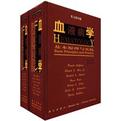血液病学:基本原理与实践:第3版:英文影印版
2001-1
科学出版社
霍夫曼 编
《血液病学:基本原理与实践(英文影印版)(套装上下册)》是世界上最好的三本血液学专著之一,为血液科、胂瘤科专业人员的必读书,目前已修订至第3版。全书由十一大部分160章组成,并配有精美的彩色插图,及详细的附录和索引。第3版在第2版的基础上按照近年来血液学的进展进行了系统的修订,有极高的参考价值。
作者:(美国)霍夫曼(Ronald Hoffman)
《血液病学:基本原理与实践(上册)》目录: PART Ⅰ Molecular and Cellular Basis of Hematology Chapter 1 Anatomy and Physiology of the Gene Chapter 2 Protein Synthesis and Intracellular Sorting Chapter 3 Protein Architecture:Relationship of Form and Function Chapter 4 Plasma Membrane Dynamics and Organization Chapter 5 Cell Adhesion Chapter 6 Control of Cell Growth and Differentiation PART Ⅱ Immunologic Basis of Hematology Chapter 7 Overview of the Immune System(Including Compartmentalization of the Immune Response) Chapter 8 B—Cell Development 80 Chapter 9 T—Cell Immunity 90 Chapter 10 Regulation of Activation of B and T Lymphocytes Chapter 11 Tolerance and Autoimmunity PART Ⅲ Biology of Stem Cells and Disorders of Hematopoiesis Chapter 12 Stem Cell Model of Hematopoiesis Chapter 13 Anatomy and Physiology of Hematopoiesis Chapter 14 Growth FactorsI Cytokines。and the Control of Hematopoiesis Chapter 15 Biology of Erythropoiesis,Erythroid Differentiation,and Maturation Chapter 16 Granulopoiesis and Monocytopoiesis Chapter 17 Thrombocytopoiesis Chapter 18 Inherited Forms of Bone Marrow Failure Chapter 19 Aplastic Anemia Chapter 20 Paroxysmal Nocturnal Hemoglobinuria Chapter 21 Pure Red Cell Aplasia PARTⅣ Red Blood Cells Chapter 22 Pathobiology of the Human Erythrocyte and Its Hemoglobins Chapter 23 Approach to the Adult and Child with Anemia Chapter 24 Anemia of Chronic Diseases Chapter 25 Erythrocytosis Chapter 26 Disorders of Iron Metabolism:Iron Deficiency and Overload Chapter 27 Heme Biosynthesis and Its Disorders:Porphyrias and Sideroblastic Anemias Chapter 28 Megaloblastic Anemias Chapter 29 Thalassemia Syndromes Chapter 30 Sickle Cell Disease Chapter 31 Hemoglobin Variants Associated with Hemolytic Anemia,Altered Oxygen Affinity and Methemoglobinemias Chapter 32 Red Cell Enzymopathies Chapter 33 Red Cell Membrane Disorders Chapter 34 Autoimmune Hemolytic Anemias Chapter 35 Extrinsic Nonimmune Hemolytic Anemias PART Ⅴ Host Defense and Its Disorders Chapter 36 Immunoglobulins:Polyclonal and Monoclonal Antibodies Chapter 37 Complement Biology Chapter 38 Normal Neutrophil Structure and Function Chapter 39 Monocyte and Macrophage Development and Function Chapter 40 Eosinophiliat Eosinophil—Associated Diseases,and the Hypereosinophilic Syndrome Chapter 41 Disorders of Phagocyte Function and Number Chapter 42 Disorders of Lymphocyte Function Chapter 43 Histiocytic Disorders Chapter 44 Lysosomal Storage Diseases:Perspective and Principles 796 Chapter 45 Infectious Mononucleosis and Other Epstein—Barr Virus—Associated Diseases 812 Chapter 46 The Spleen and Its Disorders Chapter 47 Basophils,Mast Cells,and Systemic Mastocytosis PART Ⅵ Hematologic Malignancies Chapter 48 Cytogenetics and Neoplasia …… PARTⅦ Transplantation PART Ⅷ Hemostasis and Thrombosis PARTⅨ Transfusion Medicine PART Ⅹ Consultative Hematology PARTⅪ Special Tests and Procedures Index …… 《血液病学:基本原理与实践(下册)》
版权页: 插图: The immune system must detect and respond to a broadrange of antigenic challenges from foreign substances.Although the immune system has evolved to protect the hostagainst pathogenic microorganisms,similar types ot immuneresponses are elicited by noninfectious foreign antigens as well.Furthermore,many of the nonspecific mechanisms that are engaged as the result of antigenic stimulation are used in the in-flammatory response and in the repmr of tissue damaged asthe result of noninfectious iniury such as wounding,burns,andtrauma. To succeed in its protective function,the immune responsemust react to particular antigens quickly and efficiently,especially those pathogens that it encounters repeatedly.The twohost defense systems that provide immunity against infectiousagents are the innate,or natural immune system,and the acquired(adaptive)or specific immune system(Table 7-1),Theinnate immune system is the first to respond and,as a result,limits or cures infection before an adaptive immune responseis generated.The innate immune response involves mainly non-lvmphocytic cells,including macrophages and polymorphonuclear leukocytes,as well as complement and acutephase proteins.The cells that mount the innate immune response are alsoimportant effectors in acquired or adaptive immunity.Innateimmunity iS present in all individuals all the time and does notchange with repeated exposure to antigen.If the innate immuneresPonse cures rather than limits an intection,it can preventdevelopment of adaptive immunity,in which case no long-lasting immunity is established.
《血液病学:基本原理与实践(第3版)(英文影印版)(套装共2册)》可供血液科、肿瘤科医师及医学院校研究生、教师学习、收藏。

血液病学:基本原理与实践:第3版:英文影印版 PDF格式下载